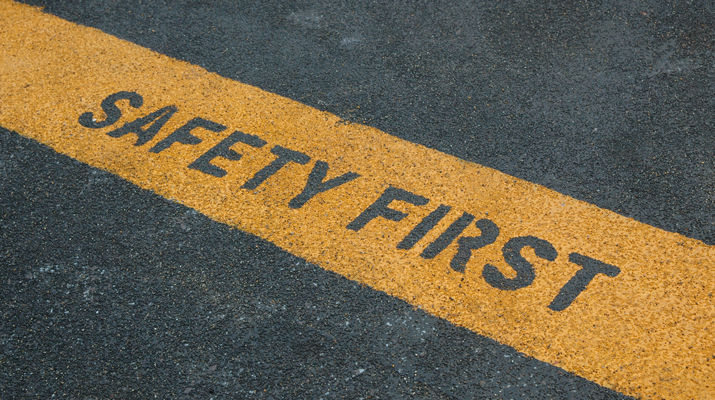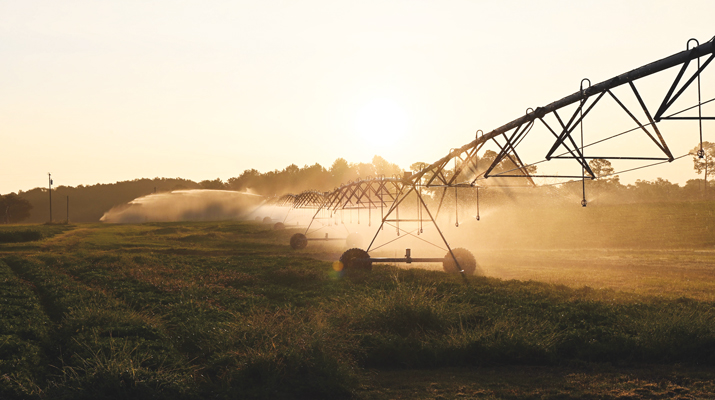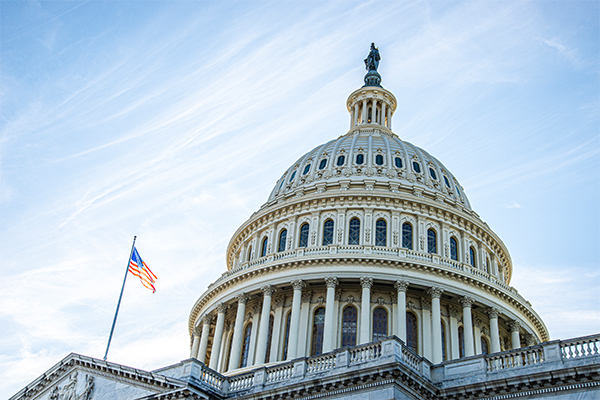VW settlement presents untapped opportunities

Propane has secured more than $35 million for school bus projects. Photo courtesy of the Propane Education & Research Council
More than a year has passed since Volkswagen (VW) announced its $2.9 billion contribution to an Environmental Mitigation Trust, resulting from its 2016 emissions cheating scandal settlement.
Since it was first announced, the contribution has had one sole purpose – to fund transportation projects that significantly decrease nitrogen oxide (NOx) emissions. Each state received millions of dollars, which could be used to finance a variety of fleets, from diesel, to electric, to propane. In fact, propane vehicles have competed from the start for up to $1.3 billion of the Environmental Mitigation Trust investment, according to Gladstein, Neandross & Associates’ Funding 360 team.
States have spent nearly $133 million in settlement awards on school buses, according to the Propane Education & Research Council (PERC). That figure continues to rise as funding opportunities remain. As of Sept. 1, the propane industry had acquired more than $35 million in VW settlement funds for school bus projects, totaling about 27 percent of the contributions, according to PERC. Diesel, however, had secured about 68 percent of the funding.
“We’re thrilled that propane autogas is the leading alternative fuel for VW funding, but unfortunately most of the funding has gone to diesel. It should be going to cleaner alternatives like propane, which reduces NOx, is cost-effective, widely available and domestically produced,” says Michael Taylor, director of autogas business development at PERC.
Proven benefits
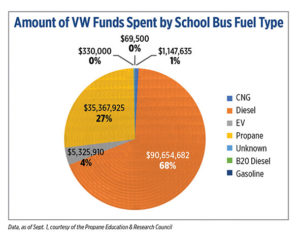
Data, as of Sept. 1, courtesy of the Propane Education & Research Council. Click to enlarge
There are two primary reasons for propane vehicles’ success so far: their ability to reduce NOx emissions and decrease the total cost of ownership.
Propane autogas is now considered a near-zero emissions energy solution, as Roush CleanTech and Greenkraft each developed new low-NOx engines in 2018. Roush says its engine is certified to the ultra-low-NOx California Air Resources Board (CARB) optional standard of 0.02 grams per brake horsepower-hour (g/bhp-hr) and emits 90 percent less NOx than the Environmental Protection Agency’s (EPA) most stringent heavy-duty engine NOx standard.
In contrast, diesel-fueled medium- and heavy-duty vehicles are the No. 1 source of NOx emissions in virtually every metropolitan region in the United States, according to the University of California-Riverside. Not to mention, the U.S. Department of Energy’s Alternative Fuels Data Center has revealed that roughly 55 percent of all manmade NOx emissions are from motor vehicles, including school buses.
“School buses are far and away the largest recipient of VW funding to date,” says Todd Mouw, president of Roush CleanTech.
“The reason for such high numbers of school bus deployments, compared with other vehicle types, is twofold,” Mouw adds. “First, school buses represent a relatively low investment of grant funds, compared to other projects like marine vessels. And, second, many states favor school bus programs, as they provide critical health benefits to a very sensitive population – our students.”
Last year, the Center for Alternative Fuels Engines and Emissions (CAFEE) at West Virginia University conducted two different tests at two different times on four Blue Bird Vision Propane school buses; these buses feature engines certified to the ultra-low-NOx CARB 0.02 g/bhp-hr standard. The tests were completed on city and highway roads, as well as on the stop-and-go routes that most school buses take on a daily basis.
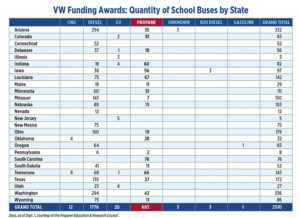
Data, as of Sept. 1, courtesy of the Propane Education & Research Council. Click to enlarge
A portable emissions measurement system was installed to measure exhaust emissions on all four buses, as test runs were performed on every bus for cold and hot starts. In all, 36 test routes were measured. Upon conclusion of the tests, the CAFEE determined that the distance-specific NOx emissions measured on diesel buses were much higher than those assessed on propane buses.
NOx emissions were, in fact, 34 times higher for diesel school buses on stop-and-go routes, as NOx and carbon dioxide declined by 96 and 13 percent, respectively, due to the propane buses. At the same time, NOx emissions were up to 19 times higher for diesel school buses on the city and highway roads, as NOx decreased by 95 percent, as a result of the propane buses.
“This substantial decline is critical for two main reasons. Diesel emissions are known to be aggravators of asthma and bronchitis, along with other respiratory issues,” Taylor says. “In children’s developing lungs, asthma is particularly problematic because it’s one of the leading causes of school absenteeism.
“In addition, students’ test scores improve significantly if they’re exposed to lower levels of school bus tailpipe emissions, according to a Georgia State University study conducted this year (the study only reviewed students’ performances on math and English tests).”
Nonetheless, the potential for propane school buses remains, to a degree, untapped, as roughly 1 million students in over 900 school districts across the United States ride in propane school buses daily.
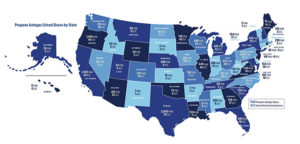
The map shows the number of propane autogas school buses in operation in each state and the number of school districts and private contractors operating school buses in each state. Data, through the end of Q1 2019, courtesy of the Propane Education & Research Council. Click to enlarge
Aside from the health benefits of propane, its influence on the United States’ economy, along with its cost-effectiveness, must not be overlooked.
According to PERC, about 90 percent of propane supplies are produced in the United States. And, since the cost of wholesale propane autogas is between the price of natural gas and oil (propane autogas’ two sources), autogas is typically less expensive than conventional fuels. Additionally, according to Argonne National Laboratory calculations from a 2017 Alternative Fuel Life-Cycle Environmental and Economic Transportation Tool, electric school buses cost, on average, $300,000, while clean diesel and propane school buses cost $90,000 and $95,000, on average, respectively.
The calculations also revealed that electric school buses decrease NOx by 1,119 pounds, while clean diesel buses diminish NOx by 67.7 pounds.
Therefore, the cost of an electric bus per pound of NOx reduced is $268, whereas the cost of a clean diesel bus per pound of NOx reduced is $1,330. To compare, propane school buses decrease NOx by 1,048.9 pounds, leading to a cost of $91 per pound of NOx reduced – 66 percent more cost-effective than electric and 93 percent more cost-effective than clean diesel.
With these benefits in mind, the following states’ propane school buses have earned VW settlement funding awards so far, leading to the deployment of about 700 new buses and, in turn, long-term economic savings, NOx emission reductions and improved health throughout an increasing number of communities and school districts across the United States.
Midwest: Propane’s popularity evident
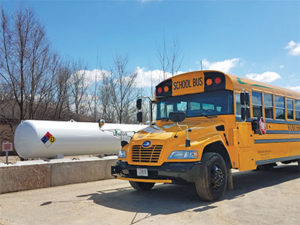
Nearly 25 percent of Kobussen Buses’ fleet are propane models. During the school year, these buses service the Oshkosh Area School District in Wisconsin. Photo courtesy of Roush CleanTech
On July 23, the Indiana Volkswagen Environmental Mitigation Trust Fund Committee approved Indiana’s first round of funding from VW’s settlement, leading to over $9.8 million in capital for 179 vehicles or equipment in 23 counties. Due to the funding, 60 propane buses will be purchased overall and used in a total of six school districts.
In the meantime, Iowa received about $21 million from the settlement, which will be utilized during three rounds of funding. More than $3 million was spent to help fleets replace buses in the first funding cycle, as 107 new school buses – half of which are powered by propane – were partially funded.
“We’re proud to say 56 propane buses were applied for and 56 propane buses were awarded,” says Debra Grooms, CEO of the Iowa Propane Gas Association.
The next round, which will focus solely on electric vehicle charging stations, isn’t expected to begin until mid-2020.

Source: Atlas Public Policy dashboard. Click to enlarge
Minnesota received $47 million from the settlement, which it will disperse in three separate phases, the first of which was recently completed. During the first phase, $11.75 million was utilized, according to the Minnesota Pollution Control Agency. Some of these funds were awarded for the purchase of 51 propane school buses.
Nebraska also recorded positive figures, with regard to propane school bus funding awards, as the state acquired $12.25 million of settlement funds. So far, grants have been awarded for 15 propane school buses. In addition, Ohio awarded funds for 19 propane school buses, as $15 million of its $75.3 million settlement will be used toward replacing diesel engines in the first round of funding, according to the Ohio EPA.
Illinois hasn’t reported as positive news. According to the Illinois EPA, the state has received $108 million from the settlement, yet none of the funds will be used toward propane purchases.
Meanwhile, Missouri was awarded $41.1 million, $12 million of which will be used for school bus replacements.
“The Missouri Propane Education and Research Council (MOPERC) has a bus rebate program, which has committed $1 million over the 10 years of the VW program to assist in propane bus adoptions,” says Steve Ahrens, president and CEO of MOPERC. “We’re offering 50 rebates of $2,000 (up to 10 per district) to leverage the VW funds to school districts who adopt propane buses, either through the VW program or on their own. For the current fiscal year, we’ve reserved 27 propane bus rebates under the MOPERC plan.”
Northeast: Untapped potential
Although the Northeast hasn’t been nearly as successful as the Midwest in regard to propane school bus funding, positive news has been reported.
For example, according to Deanna Cuccinello of the Delaware Division of Air Quality, the state has awarded funding for the purchase of 18 propane school buses as part of its more than $9.6 million settlement. In fact, the entire first phase of funding (of three overall) was dedicated to replacing old diesel school buses with new, cleaner buses.
Furthermore, Maine approved the purchase of 11 propane school buses, as it was allocated $21 million from the settlement, according to the state’s Department of Transportation.
Leslie Anderson, president and CEO of the Propane Gas Association of New England, is positive about New Hampshire as well, as it has set aside money for propane school buses. It hasn’t purchased any yet, but it has been awarded $30.9 million from the settlement.
“There will be another round of grants, starting with Connecticut for its second round shortly, so we hope the coming years will be much more successful for the propane industry,” she explains.
Massachusetts, Rhode Island and Vermont chose to dedicate their entire first rounds to electric vehicles, as the states received $75 million, $14.4 million and $18.7 million, respectively. Massachusetts spent $23.5 million during the first round of funding alone – on electric transit buses and vehicles.
“Simply put, we haven’t told our green story well enough,” Anderson explains. “That must change quickly.”
South: Where it all began
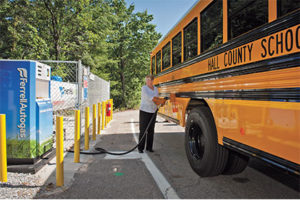
Though Georgia only awarded VW settlement funding for electric vehicles thus far, propane autogas school buses are still rolling in the state, with about 800 on the roads. Photo courtesy of Roush CleanTech
Louisiana was the first state to disburse its Environmental Mitigation Trust funds, as Lafayette Parish Schools was the first recipient of the settlement, using the funds to buy 10 new Blue Bird Vision Propane school buses, according to School Bus Fleet.
Thus far, the state has approved the purchase of 67 propane school buses, as its entire settlement ($19.8 million) will be used to replace older diesel school buses. To replace these buses, the school districts can either utilize the funds to cover 25 percent of new diesel buses’ purchase costs or 50 percent of new propane buses’ purchase costs.
The propane industry has also found success in Oklahoma, South Carolina and Tennessee, as the states planned to purchase 28, 78 and 66 propane school buses, respectively.
According to the Oklahoma Department of Environmental Quality, the state acquired $21 million from the settlement and introduced the Alternative Fuel School Bus Program ($4.1 million to use toward projects that promote alternative fuel usage) and the Clean Diesel program (an EPA-sponsored program to retrofit or replace diesel vehicles and buses) during the first round of funding.
South Carolina and Tennessee, meanwhile, were allocated nearly $34 million and $46 million, respectively, from the settlement. South Carolina is using $9.33 million to replace 81 buses, 78 of which are on propane, according to the South Carolina Department of Insurance. Tennessee was awarded roughly $9 million to support its bus replacement projects, according to Tennessee Clean Fuels.
Such figures weren’t reported in Georgia, though. Despite receiving more than $63.6 million from the settlement, the state only awarded funding for the purchase of electric vehicles and technology – the South’s most noteworthy disappointment in 2019.
West: Shifting the narrative
Colorado was originally awarded funding for nearly 200 propane school buses, prior to the inauguration of Gov. Jared Polis, who issued an executive order that rescinded propane school bus funding during his first day in office. A zero-emissions vehicle policy was established as a result, thereby forcing the allocation of significant funds toward the support of transportation electrification.
“Therefore, these propane buses, which would have substantially reduced statewide NOx emissions, will be replaced with 50 new electric-powered transit buses,” says Dan Binning, executive director of the Colorado and New Mexico propane gas associations. “Per bus, they’ll cost over $1 million each. In contrast, approximately 250 propane-powered school buses could have been purchased with less money.”
However, Colorado is making inroads with propane, awarding funds for the purchase of 81 propane-powered school buses, as of early September.
Binning remains optimistic.
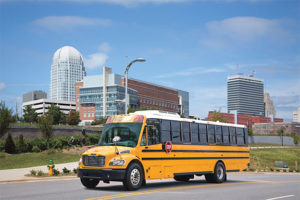
About 700 propane autogas school buses – across all manufacturers – have been acquired as a result of the VW settlement funding. Photo courtesy of Thomas Built Buses
“I believe we’ll eventually see a steady conversion of school bus fleets to propane, though, as propane’s environmental and economic values are manifested.”
California and Washington were awarded $423 million and $112.7 million, respectively. While Washington has been awarded grants for 42 propane buses, California has not indicated its intent to award funding for propane vehicles. Initial meetings between the Western Propane Gas Association (WPGA) and CARB were promising, though, according to Joy Alafia, the association’s president and CEO.
“CARB appeared to understand the value propane provided as the most cost-effective way to mitigate NOx emissions, but we were surprised by its strategy to go all electric except for when dealing with Class 8 engines,” Alafia states. “We feel fuel diversity is an extremely important strategy, especially when electric vehicles can’t meet fleet owner demands.”
As the WPGA prepares for the future, it’s currently working on a broader adoption of clean propane vehicles, as it showcases propane at clean transportation conferences.
“We’re shifting our narrative to sustainability with renewable propane when facing forced electric grid blackouts,” she adds. “The challenge of climate change is too great for an overly simplistic, one-technology solution.”
Engage with state agencies
While preparing for the next rounds of states’ settlement funds, Mouw will continue to ensure states understand all of the benefits of propane and, just as importantly, have the means to fully fund those benefits. To do so, Roush CleanTech will engage with state environmental and transportation agencies, which Mouw believes is critical to propane autogas’ overall success.
“In our experience, state mitigation agencies are receptive and willing to engage stakeholders,” Mouw says. “We need to make sure state agencies understand the options that are available for emissions quantification, including the Argonne Heavy-Duty Vehicle Emissions Calculator, which has incorporated updated emissions data for new engine technology that’s used in near-zero propane school buses.”
Tucker Perkins, president and CEO of PERC, adds that all state propane gas associations and propane marketers should engage with their local Clean Cities organizations, along with other state environmental and transportation agencies, regarding the VW Environmental Mitigation Trust.
To provide assistance, PERC has recently launched the Volkswagen Trust Resource Center, a webpage available at propane.com that contains concise resources developed specifically to educate visitors about the benefits of propane autogas. Moreover, PERC has allocated resources, including personnel who are working closely with Clean Cities organizations, state executives and propane marketers to engage, inform and educate state mitigation agencies about the environmental, social and economic benefits of propane autogas.
“Together, we must continue to reach out to state beneficiaries and explain how propane vehicles will substantially reduce NOx, while also providing safer, healthier communities,” Perkins stresses. “Propane is the ideal fuel for VW funding, and its potential will be realized if everyone in the propane industry becomes involved.”








